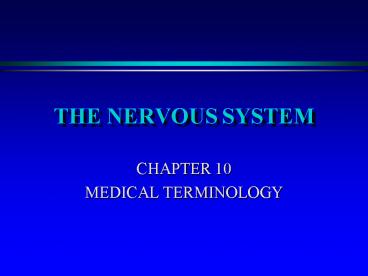THE NERVOUS SYSTEM - PowerPoint PPT Presentation
1 / 21
Title:
THE NERVOUS SYSTEM
Description:
Have you ever wondered what causes your body to do the ... A Plexus. Receptors. NEURONS. What is a neuron? Neurons are the basic cells of the nervous system ... – PowerPoint PPT presentation
Number of Views:40
Avg rating:3.0/5.0
Title: THE NERVOUS SYSTEM
1
THE NERVOUS SYSTEM
- CHAPTER 10
- MEDICAL TERMINOLOGY
2
FUNCTION OF THE NERVOUS SYSTEM
- Have you ever wondered what causes your body to
do the things it does? - Control of the bodys billions of cells is
accomplished by - the nervous system
- the endocrine system
- Parts of the nervous system communicate
information to body structures
3
ORGANS OF THE NERVOUS SYSTEM
- BRAIN
- SPINAL CORD
- NERVES OF THE BODY
- Lets examine each of these in detail
4
NERVES
- Nerves are a combination of cells
- Nerves are a group of impulse carrying fibers
that connect the brain and spinal cord with other
parts of the body - Other terms associated with nerves are
- A Ganglion
- A Plexus
- Receptors
5
NEURONS
- What is a neuron?
- Neurons are the basic cells of the nervous system
- Each neuron consists of 3 parts
- CELL BODY
- DENDRITES
- AXON
6
DENDRITES/AXONS
Jugular vein
- DENDRITES
- Branch like projections off the cell body
- Receive impulses and conduct the impulses to the
cell body
7
DENDRITES/AXONS
- AXONS
- Axons look like elongated projections
- Axons transmit impulses away from the cell body
- Groups of wrapped axons are fascicles
- DENDRITES
- Branch like projections off the cell body
- Receive impulses and conduct the impulses to the
cell body
8
NEURONS
- There are 3 types of neurons according to the
direction in which they transmit impulses - SENSORY NEURONS
- MOTOR NEURONS
- INTERNEURONS
9
NEUROTRANSMITTERS
- What are neurotransmitters?
- Chemicals by which neurons communicate.
- This chemical substance helps impulses jump
across the synapse so the impulse can continue
along its pathway or reflex arc
10
NEUROGLIA
- Neuroglia are supportive and connective cells
- They do not transmit impulses
- They hold the functioning neurons together
11
DIVISIONS OF THE NERVOUS SYSTEM
- The nervous system is divided into 3 parts
- Central Nervous System
- Peripheral Nervous System
- Autonomic Nervous System
- Lets examine each of these systems
12
CENTRAL NERVOUS SYSTEM
- The Central Nervous System consists of
- Brain
- Spinal Cord
13
THE BRAIN
- DIVISIONS OF THE BRAIN
- Brain Stem
- Medulla Oblongata
- Pons
- Midbrain
- Cerebellum
- Diencephalon
- Cerebrum
14
THE BRAIN STEM
- Medulla oblongata is located at the lowest part
of the brain and consists of gray and white
matter - Pons consists of gray and white matter and is
situated at the base of the brain where the nerve
cells cross from one side of the brain to control
the opposite side of the body - Midbrain consists of gray and white matter
15
THE BRAIN AND ITS PARTS
- Cerebellum the 2nd largest part of the brain
- Cerebrum the largest and uppermost part of the
brain. Its divided into 4 lobes
16
DIENCEPHALON
- The diencephalon is a small part of the brain and
consists of - Hypothalamus
- Thalamus
17
THE SPINAL CORD
- The main function of the spinal cord is to carry
nerve impulses that affect the limbs and lower
parts of the body - Both the brain and spinal cord are protected by
the meninges and cerebrospinal fluid
18
MENINGES FLUID
- The meninges consists of 3 layers of tissue
- The Dura Mater
- The Arachnoid Membrane
- The Pia Mater
- Cerebrospinal Fluid is a clear, colorless fluid
that flows throughout the brain and around the
spinal cord and helps to cushion these organs
19
PERIPHERAL NERVOUS SYSTEM
- Consists of
- Crainal Nerves
- Spinal Nerves
- There are 12 pairs of crainal nerves
- There are 31 pairs of spinal nerves and they are
names after the artery they accompany or the body
part they innervate
20
AUTONOMIC NERVOUS SYSTEM
- The autonomic nervous system consists of motor
neurons. There are 2 divisions of the autonomic
nervous system - Sympathetic Nervous System
- Parasympathetic Nervous System
21
(No Transcript)































